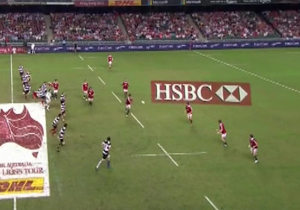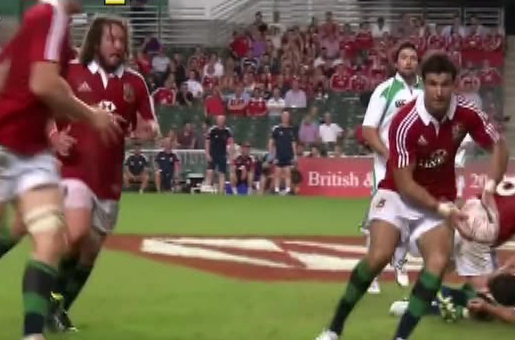 In the first five parts of this series I’ve looked at the potential players for the Lions and Wallabies and showed you some brief glimpses of what we might see from the Lions in attack. Today to finish the series I’m going to look at the Lions probable attack system.
In the first five parts of this series I’ve looked at the potential players for the Lions and Wallabies and showed you some brief glimpses of what we might see from the Lions in attack. Today to finish the series I’m going to look at the Lions probable attack system.
Every international team uses a system in attack – with so much emphasis on the improvement in defences it’s not viable to use an unstructured attack plan where players “play what’s in front of them” and just react to what the defence is doing and effectively make it up as they go.
The equation many seem to believe regarding the 2013 Lions in attack is:
Lions = Wales = Conservative, direct attack
The first part of that equation is valid but the second part ignores the fact that Wales are not a conservative team in attack.
I’ll offer a different equation to describe the Lions in attack:
Wales 2008-2009 = Lions 2009 = Wales 2009-2013 = Lions 2013 = Balanced attack between direct and expansive attack
The Welsh attack system has been the same for many years and it’s quite basic. Descriptions of how it works go something like this – either kick the ball down field or a) crash ball from Jamie Roberts; b) forward pods running close to the ruck same way across the field for a few phases; c) ball passed behind a screen of three forwards and try to get it to their big wingers on the opposite touch line; and d) repeat a) to c).
Yes, you see all of those elements in the Welsh attack system and yes, their system hasn’t changed much for years but there’s more to it than that. The system is basic and it’s very similar to the systems used by many other international teams – there’s no revolutionary stuff included but who tries to be revolutionary with their attack system in international rugby? That approach just wouldn’t work – you have players coming in from various teams who have all been playing with different attack systems and calls and you have to get them working together in a reasonably short space of time.
Therefore you keep things basic and work on developing combinations within the system as quickly as possible – that process is made easier if the system you’re using is the same or similar to what’s been used by the group of players in the past.
In the case of Wales they’ve been reasonably successful in the last six years – no doubt they would have liked better results against Sothern Hemisphere teams but they’ve won three Six Nations tournaments since 2008, two of which included grand slams. As a result Welsh players have made up the majority of the 2009 and 2013 Lions squads so it’s no surprise that Wales have retained a pretty similar attack system for some time and that the system was largely adopted by the 2009 Lions team.
I think an attack system consists of two parts – firstly the pattern, which defines where you want to go on the field – an example of this is the Crusaders wide-wide attack pattern where the ball is moved from touch line to touch line repeatedly to try and stretch the defence. The second part is the structure – what sort of shape is used (or where do players position themselves) to move the ball according to the pattern – an example is the Waratahs use of a three man pod of forwards in the shape of an arrowhead which is repeated within their pattern.
I’ve broken the video today into two parts – Part A looks at the Welsh attack system with examples from matches in 2012 and 2013 including the final match of the Six Nations that Robbie Deans has said showed the direct attack we’ll see from the Lions. You’ll see that the structure they use involves two groups of players that I’ve called the ‘Punch’ and ‘Spread’ groups – the Punch group normally consists of forwards but can include backs when required and the Spread group normally consists of the backs but can include forwards.
You’ll see that the pattern is the Punch group playing directly at the opposition defensive line until space opens up wider for the Spread group – if space doesn’t open up the Punch group keeps working the ball the same way phase after phase across field until the far touch line is reached. Then the aim is to move the ball back the other way to the Spread group. As I said – nothing complicated or different to what you see at most levels of competitive rugby.
Part B of the video looks at the Lions on the 2009 tour to South Africa and you’ll see the similarity between the attack system they used to that of Wales.
I know people generally prefer short, sharp videos on the Internet but with so much content to discuss these videos are longer than usual – hopefully that doesn’t put you off. The original cut of the video was 47 minutes long with so many examples of this attack system I could show you.
You’ll see that the Punch group can receive the ball from either the #9 or the #10 but it is preferable to have that group fed by by the #9 so that the #10 can stay out with the Spread group ready to receive the ball on the next phase and feed them.
One important thing with the use of an attacking system is that if an opportunity arises that is outside the system, players need to drop the system immediately and take advantage of the opportunity that has been presented – you don’t get enough opportunities to ignore them for the sake of staying true to a system you’re using.
The system used by Wales and the Lions on the 2009 tour is based on the ball being moved away from the ruck but when the opposition defensive line starts to spread to counter this, they will break out of the system and play directly using pick and drives to drag defenders back closer to the ruck – this is the direct play people refer to and no doubt we’ll see that from the 2013 Lions as well whenever the Wallabies spread out and leave space around the ruck.
Can we expect to see a similar attack system from the 2013 Lions to what I’ve shown in the videos? It would make sense – with a large number of players from Wales and a large number of players from the 2009 Lions tour expected to make the Lions test team the use of a system that they’re used to would help in getting combinations working faster. No doubt there will be some variations as you don’t want to be too predictable but I expect we’ll see the same basic system.
Since preparing the videos and drafting this article we’ve seen the Lions play the Barbarians in the tour opener last night and although the Barbarians defence in the final two thirds of the match was so poor that the match opened up, in the first twenty minutes we saw the same attacking system I’ve described here in use by the Lions. Just watch the first possession the Lions had in Hong Kong to see it in use.
Knowing what’s coming and being able to defend against it successfully are two different things. The Wallaby coaches and their team of analysts will have been all over this attack system for months so despite Robbie Deans making public comments that he expects the Lions to play direct, conservative rugby I doubt that’s what they’ll really be planning for.

